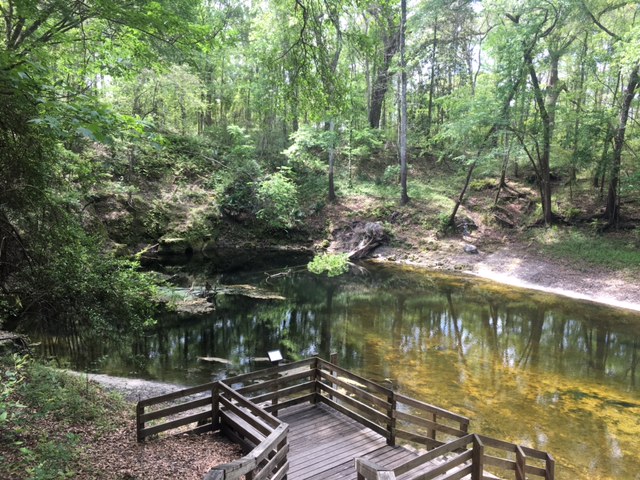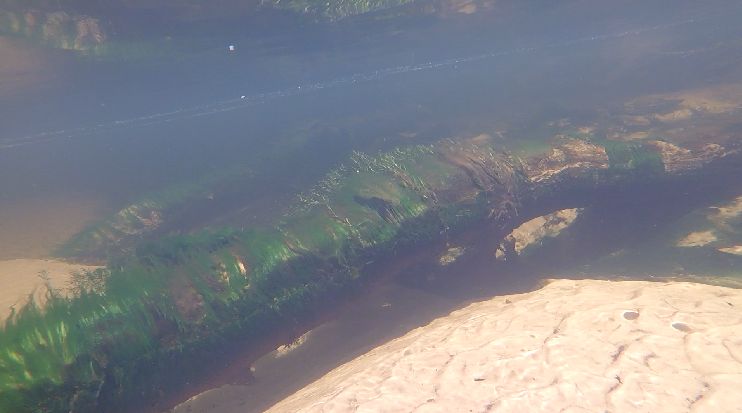Lafayette Blue Spring was a little weird because of the limestone bridge that bisects its pool, but Falmouth Spring was truly weird. Falmouth is strange enough that it has an entry on the Atlas Obscura website (http://www.atlasobscura.com/places/falmouth-springs), which describes itself as: “the definitive guide to the world’s wondrous and curious places”. Falmouth Spring is not truly a spring; it feels like a giant crack in an otherwise normal forest with water flowing through it. In reality, it is a more of an underground river with a short stretch that is exposed to the surface. Its water, which was fairly brown when I visited, comes out of an underground vent, travels 450 feet, then disappears into a limestone wall. The water whirls around as it funnels into the cave in the wall, producing a slightly creepy whirlpool effect.

The source of the water (the “headspring”) of Falmouth Spring. The pool was deep enough that I could not see the bottom, even with the camera, in the dark water.

The Falmouth “run” as it leaves the “headspring”. It was very shallow and fast flowing. While I was working, an old man in swimming gear showed up and swam in this part of the run. He swam hard without moving, the flow was that strong.

The Falmouth run as it enters the second pool that is drained by the cave. Yes, that is a tiny section of rapids–so rare in Florida!

The limestone wall into which the water disappeared. The darkest spot is the cave.

A closer view of the limestone wall; the cave is the opening. I felt as if my kayak was going to get sucked in if I got too close. Images of a scene from Willy Wonka and the Chocolate Factory were whirling around my head–only with limestone and brown water.
Falmouth Spring looks even a little weirder from aerial view because it is actually fairly far from the Suwannee River. I found it relatively easily on Google Earth as a break in the trees on the Falmouth Spring Conservation Area.

Google Earth image of the landscape around Falmouth Spring. The Suwannee runs through the band of green to the west.

Closer aerial view of Falmouth Spring. The dark area just below the marker is the “spring”.
The average discharge of Falmouth Spring is surprisingly high. For 2014 and 2015, the average discharge was 131 cfs, which is almost as high as Volusia Blue Spring. Of course, it also had a period in January 2015 when its discharge was -110 cfs; the spring is known to reverse periodically. The nutrient concentrations also were fairly high; the nitrate concentration was 1.02 mg/L for 2016-2017 and the phosphate concentration was likely about 0.06 mg/L (it was measured less recently), according to SRWMD (http://www.mysuwanneeriver.org/portal/springs.htm). Not surprisingly, given the underground source of the water, the relatively high nutrient concentrations, the spring reversals, and the abundant dead algae in the upstream end, dissolved oxygen concentrations were quite low (0.36-1.18 mg/L).

Dead algae on a downed tree in the “headspring”. If you look closely, there is a fish swimming away from the tree. There were a lot of fish congregating around this tree, which fell across halfway across the “headspring”.
The run looked a bit healthier; it supported live algae as well as large plants (probably Potamogeton sp.).

Live algae and plants over sand substrate in the Falmouth run.
I was surprised to find any fish in this spring other than mosquitofish (Gambusia holbrooki), given the lack of above ground connections, but I observed least killifish (Heterandria formosa), shiners (Notropis sp.), two species of sunfish (Lepomis sp.), and two longnose gar (Lepisosteus osseus) in addition to mosquitofish. Did all of these fish travel underground to Falmouth??? I observed all of these fish in the “headspring” and in the run; I did not see any fish in the last pool. Did any fish that ventured down there get sucked into the cave?????

Two longnose gar in the “headspring” of Falmouth Spring.
Although I did not find any fish in the last pool, I found snails on the plants at the top of the pool (the bottom of the run).

Plants at the bottom of the fast flowing run, just before the deep pool that leads to the cave. The dark brown dots all over the plants are snails.
Definitely among the weirder places that I’ve been in my life.